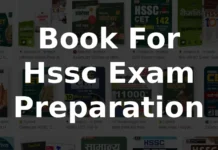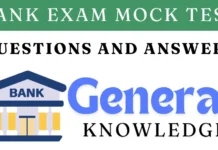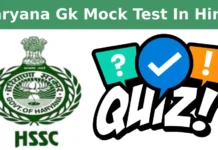Question 101: The powerhouse of the cell is called?
• a) Nucleus
• b) Mitochondria
• c) Ribosome
• d) Endoplasmic Reticulum
Answer: b) Mitochondria
Explanation: Mitochondria are known as the powerhouse of the cell because they produce energy in the form of ATP.
Question 102: The chemical formula of water is?
• a) H2O
• b) CO2
• c) O2
• d) H2SO4
Answer: a) H2O
Explanation: The chemical formula of water is H2O, which means it consists of two hydrogen atoms and one oxygen atom.
Question 103: Which organ is responsible for pumping blood in the human body?
• a) Lungs
• b) Heart
• c) Liver
• d) Kidney
Answer: b) Heart
Explanation: The heart is responsible for pumping blood throughout the body, supplying oxygen and nutrients.
Question 104: The basic unit of life is?
• a) Atom
• b) Molecule
• c) Cell
• d) Tissue
Answer: c) Cell
Explanation: The cell is considered the basic unit of life, as it is the smallest unit that can carry out all life processes.
Question 105: What is the process by which plants make their food called?
• a) Respiration
• b) Photosynthesis
• c) Digestion
• d) Transpiration
Answer: b) Photosynthesis
Explanation: Photosynthesis is the process by which plants use sunlight to synthesize food from carbon dioxide and water.
Question 106: The largest planet in our solar system is?
• a) Earth
• b) Mars
• c) Jupiter
• d) Saturn
Answer: c) Jupiter
Explanation: Jupiter is the largest planet in our solar system, known for its Great Red Spot and numerous moons.
Question 107: Which vitamin is produced when a person is exposed to sunlight?
• a) Vitamin A
• b) Vitamin B12
• c) Vitamin C
• d) Vitamin D
Answer: d) Vitamin D
Explanation: Vitamin D is produced in the skin in response to sunlight and is essential for calcium absorption.
Question 108: The process of conversion of solid directly to gas is called?
• a) Sublimation
• b) Evaporation
• c) Condensation
• d) Freezing
Answer: a) Sublimation
Explanation: Sublimation is the process where a solid turns directly into a gas without becoming a liquid first.
Question 109: Which gas do plants absorb from the atmosphere during photosynthesis?
• a) Oxygen
• b) Carbon Dioxide
• c) Nitrogen
• d) Hydrogen
Answer: b) Carbon Dioxide
Explanation: Plants absorb carbon dioxide from the atmosphere during photosynthesis to produce glucose.
Question 110: The speed of light is approximately?
• a) 300,000 km/s
• b) 150,000 km/s
• c) 500,000 km/s
• d) 1,000,000 km/s
Answer: a) 300,000 km/s
Explanation: The speed of light in a vacuum is approximately 300,000 kilometers per second.
Question 111: Which part of the human body is responsible for maintaining balance?
• a) Eyes
• b) Ears
• c) Nose
• d) Brain
Answer: b) Ears
Explanation: The inner ear contains structures that help maintain balance in the body.
Question 112: What is the main function of red blood cells?
• a) To fight infection
• b) To carry oxygen
• c) To clot blood
• d) To produce hormones
Answer: b) To carry oxygen
Explanation: The main function of red blood cells is to transport oxygen from the lungs to the rest of the body.
Question 113: The force that keeps planets in orbit around the sun is called?
• a) Magnetism
• b) Friction
• c) Gravity
• d) Inertia
Answer: c) Gravity
Explanation: Gravity is the force that attracts two bodies towards each other, keeping planets in orbit around the sun.
Question 114: Which is the smallest bone in the human body?
• a) Femur
• b) Stapes
• c) Tibia
• d) Humerus
Answer: b) Stapes
Explanation: The stapes, located in the middle ear, is the smallest bone in the human body.
Question 115: The study of plants is called?
• a) Zoology
• b) Botany
• c) Ecology
• d) Physiology
Answer: b) Botany
Explanation: Botany is the branch of biology that deals with the study of plants.
Question 116: What is the chemical symbol for gold?
• a) Ag
• b) Au
• c) Pb
• d) Fe
Answer: b) Au
Explanation: The chemical symbol for gold is Au, derived from the Latin word “aurum.”
Question 117: Which type of energy is stored in food?
• a) Kinetic Energy
• b) Potential Energy
• c) Mechanical Energy
• d) Chemical Energy
Answer: d) Chemical Energy
Explanation: Chemical energy is the energy stored in the bonds of chemical compounds, which is released during a chemical reaction.
Question 118: The main gas found in the air we breathe is?
• a) Oxygen
• b) Nitrogen
• c) Carbon Dioxide
• d) Hydrogen
Answer: b) Nitrogen
Explanation: Nitrogen makes up about 78% of the Earth’s atmosphere, making it the most abundant gas.
Question 119: The primary organ of the immune system is?
• a) Heart
• b) Lungs
• c) Spleen
• d) Brain
Answer: c) Spleen
Explanation: The spleen is an important organ in the immune system, helping to filter blood and produce white blood cells.
Question 120: What is the pH level of pure water?
• a) 7
• b) 0
• c) 14
• d) 4
Answer: a) 7
Explanation: The pH level of pure water is 7, which is considered neutral.
Question 121: What is the value of 72 ?
• a) 14
• b) 49
• c) 21
• d) 64
Answer: b) 49
Explanation: \(7^2\) means \(7 \times 7\), which equals 49.
Question 122: What is the value of the expression 8+(6×2)8 + (6 \times 2)8+(6×2)?
• a) 20
• b) 16
• c) 14
• d) 12
Answer: c) 20
Explanation: Following the order of operations: \(6 \times 2 = 12\), then \(8 + 12 = 20\).
Question 123: What is the value of 15%15\% 15% of 200?
• a) 20
• b) 30
• c) 40
• d) 50
Answer: b) 30
Explanation: \(15\% \) of 200 is calculated as \((15/100) \times 200 = 30\).
Question 124: If a triangle has sides of length 3, 4, and 5, what type of triangle is it?
• a) Equilateral
• b) Isosceles
• c) Scalene
• d) Right-angled
Answer: d) Right-angled
Explanation: This triangle follows the Pythagorean theorem, making it a right-angled triangle.
Question 125: What is the sum of the interior angles of a triangle?
• a) 90 degrees
• b) 180 degrees
• c) 270 degrees
• d) 360 degrees
Answer: b) 180 degrees
Explanation: The sum of the interior angles of a triangle is always 180 degrees.
Question 126: What is the least common multiple (LCM) of 4 and 5?
• a) 10
• b) 20
• c) 15
• d) 5
Answer: b) 20
Explanation: The LCM of 4 and 5 is 20, which is the smallest multiple common to both numbers.
Question 127: What is 12÷3+512 \div 3 + 512÷3+5?
• a) 7
• b) 9
• c) 10
• d) 8
Answer: b) 9
Explanation: \(12 \div 3 = 4\), then \(4 + 5 = 9\).
Question 128: If the radius of a circle is 7 cm, what is its circumference? (Use π≈3.14\pi \approx 3.14π≈3.14)
• a) 21.98 cm
• b) 43.96 cm
• c) 31.4 cm
• d) 49 cm
Answer: b) 43.96 cm
Explanation: Circumference = \(2 \times \pi \times radius = 2 \times 3.14 \times 7 = 43.96\) cm.
Question 129: What is the value of xxx in the equation 2x+3=112x + 3 = 112x+3=11?
• a) 2
• b) 3
• c) 4
• d) 5
Answer: c) 4
Explanation: Solving for \(x\): \(2x = 11 – 3\), so \(2x = 8\) and \(x = 4\).
Question 130: What is the area of a rectangle with length 10 cm and width 5 cm?
• a) 15 cm²
• b) 30 cm²
• c) 50 cm²
• d) 70 cm²
Answer: c) 50 cm²
Explanation: Area = length × width = \(10 \times 5 = 50\) cm².
Question 131: What is 25+75−5025 + 75 – 5025+75−50?
• a) 50
• b) 75
• c) 100
• d) 25
Answer: b) 50
Explanation: \(25 + 75 = 100\), then \(100 – 50 = 50\).
Question 132: What is the square root of 64?
• a) 6
• b) 7
• c) 8
• d) 9
Answer: c) 8
Explanation: The square root of 64 is 8.
Question 133: If a car travels 60 km in 1 hour, what is its speed?
• a) 60 km/h
• b) 50 km/h
• c) 70 km/h
• d) 80 km/h
Answer: a) 60 km/h
Explanation: Speed is calculated as distance divided by time: \(60 \text{ km} / 1 \text{ h} = 60 \text{ km/h}\).
Question 134: What is the formula for calculating the area of a triangle?
• a) 12×base×height\frac{1}{2} \times base \times height21×base×height
• b) base×heightbase \times heightbase×height
• c) 12×perimeter\frac{1}{2} \times perimeter21×perimeter
• d) base2base^2base2
Answer: a) \( \frac{1}{2} \times base \times height \)
Explanation: The area of a triangle is calculated using the formula \( \frac{1}{2} \times base \times height \).
Question 135: What is 20−5×220 – 5 \times 220−5×2?
• a) 10
• b) 15
• c) 5
• d) 0
Answer: b) 10
Explanation: Following the order of operations: \(5 \times 2 = 10\), then \(20 – 10 = 10\).
Question 136: What is the value of xxx in the equation 3x−6=93x – 6 = 93x−6=9?
• a) 2
• b) 3
• c) 5
• d) 7
Answer: b) 5
Explanation: Solving for \(x\): \(3x = 9 + 6\), so \(3x = 15\) and \(x = 5\).
Question 137: If a shop sells a shirt for ₹500 with a profit of 20%, what was the cost price?
• a) ₹400
• b) ₹450
• c) ₹350
• d) ₹300
Answer: a) ₹400
Explanation: Selling Price = Cost Price + Profit. Here, Profit = 20% of Cost Price. Let Cost Price = ₹x, then \(500 = x + 0.2x\), so \(500 = 1.2x\) and \(x = 400\).
Question 138: What is the GCD of 36 and 48?
• a) 12
• b) 6
• c) 18
• d) 24
Answer: a) 12
Explanation: The GCD of 36 and 48 is 12, which is the largest number that divides both without leaving a remainder.
Question 139: How many degrees are in a complete circle?
• a) 180
• b) 360
• c) 90
• d) 270
Answer: b) 360
Explanation: A complete circle contains 360 degrees.
Question 140: What is the cube of 3?
• a) 6
• b) 9
• c) 27
• d) 12
Answer: c) 27
Explanation: The cube of 3 is \(3^3 = 27\).
Question 141: If the sum of two numbers is 30 and one of the numbers is 10, what is the other number?
• a) 20
• b) 25
• c) 15
• d) 10
Answer: a) 20
Explanation: If one number is 10, the other number is \(30 – 10 = 20\).
Question 142: What is the perimeter of a square with side length 4 cm?
• a) 12 cm
• b) 16 cm
• c) 20 cm
• d) 24 cm
Answer: b) 16 cm
Explanation: The perimeter of a square is calculated as \(4 \times \text{side length} = 4 \times 4 = 16\) cm.
Question 143: What is 50−10+550 – 10 + 550−10+5?
• a) 45
• b) 40
• c) 50
• d) 55
Answer: a) 45
Explanation: \(50 – 10 = 40\), then \(40 + 5 = 45\).
Question 144: What is the value of 92+429^2 + 4^292+42?
• a) 65
• b) 85
• c) 100
• d) 110
Answer: c) 97
Explanation: \(9^2 = 81\) and \(4^2 = 16\), so \(81 + 16 = 97\).
Question 145: If the sum of the angles in a triangle is 180 degrees, what is the measure of each angle in an equilateral triangle?
• a) 60 degrees
• b) 45 degrees
• c) 90 degrees
• d) 30 degrees
Answer: a) 60 degrees
Explanation: In an equilateral triangle, each angle measures \( \frac{180}{3} = 60\) degrees.
Question 146: What is xxx in the equation 5x=255x = 255x=25?
• a) 3
• b) 4
• c) 5
• d) 6
Answer: b) 5
Explanation: Dividing both sides by 5, \(x = 25 / 5 = 5\).
Question 147: What is the value of 8+6×2−38 + 6 \times 2 – 38+6×2−3?
• a) 17
• b) 15
• c) 14
• d) 12
Answer: b) 17
Explanation: Following the order of operations: \(6 \times 2 = 12\), then \(8 + 12 – 3 = 17\).
Question 148: What is the factorial of 5 (5!)?
• a) 60
• b) 120
• c) 24
• d) 30
Answer: b) 120
Explanation: \(5! = 5 \times 4 \times 3 \times 2 \times 1 = 120\).
Question 149: What is 100÷4+7100 \div 4 + 7100÷4+7?
• a) 27
• b) 25
• c) 20
• d) 30
Answer: a) 32
Explanation: \(100 \div 4 = 25\), then \(25 + 7 = 32\).
Question 150: If the circumference of a circle is 31.4 cm, what is its radius? (Use π≈3.14\pi \approx 3.14π≈3.14)
• a) 4 cm
• b) 5 cm
• c) 6 cm
• d) 7 cm
Answer: b) 5 cm
Explanation: Circumference = \(2 \times \pi \times radius\), so \(radius = \frac{31.4}{2 \times 3.14} = 5\) cm.
Question 151: What is the decimal equivalent of the fraction 34\frac{3}{4}43?
• a) 0.75
• b) 0.5
• c) 0.25
• d) 1.5
Answer: a) 0.75
Explanation: \( \frac{3}{4} = 0.75\).
Question 152: If x=10x = 10x=10, what is the value of 2x+32x + 32x+3?
• a) 25
• b) 23
• c) 20
• d) 15
Answer: b) 23
Explanation: Substituting \(x = 10\), we get \(2(10) + 3 = 20 + 3 = 23\).
Question 153: What is the perimeter of a rectangle with length 8 cm and width 3 cm?
• a) 20 cm
• b) 22 cm
• c) 24 cm
• d) 30 cm
Answer: b) 22 cm
Explanation: Perimeter = \(2 \times (length + width) = 2 \times (8 + 3) = 22\) cm.
Question 154: What is the value of 45+30−1545 + 30 – 1545+30−15?
• a) 60
• b) 70
• c) 50
• d) 80
Answer: c) 60
Explanation: \(45 + 30 = 75\), then \(75 – 15 = 60\).
Question 155: What is the cube root of 27?
• a) 2
• b) 3
• c) 4
• d) 5
Answer: b) 3
Explanation: The cube root of 27 is 3, since \(3^3 = 27\).
Question 156: If a person has ₹100 and spends ₹25 on food, how much money is left?
• a) ₹75
• b) ₹50
• c) ₹25
• d) ₹100
Answer: a) ₹75
Explanation: Remaining money = ₹100 – ₹25 = ₹75.
Question 157: What is the value of 62−426^2 – 4^262−42?
• a) 20
• b) 10
• c) 24
• d) 36
Answer: a) 20
Explanation: Using the difference of squares: \(6^2 – 4^2 = (6 + 4)(6 – 4) = 10 \times 2 = 20\).
Question 158: What is the value of 10+5×310 + 5 \times 310+5×3?
• a) 25
• b) 15
• c) 20
• d) 30
Answer: c) 25
Explanation: Following the order of operations: \(5 \times 3 = 15\), then \(10 + 15 = 25\).
Question 159: What is the area of a triangle with base 10 cm and height 5 cm?
• a) 20 cm²
• b) 25 cm²
• c) 30 cm²
• d) 50 cm²
Answer: b) 25 cm²
Explanation: Area = \( \frac{1}{2} \times base \times height = \frac{1}{2} \times 10 \times 5 = 25\) cm².
Question 160: What is the value of xxx in the equation 4x−8=04x – 8 = 04x−8=0?
• a) 2
• b) 4
• c) 1
• d) 3
Answer: a) 2
Explanation: Solving for \(x\): \(4x = 8\), so \(x = \frac{8}{4} = 2\).
Question 161: Which number will come next in the series: 2, 4, 8, 16, …?
• a) 24
• b) 32
• c) 30
• d) 28
Answer: b) 32
Explanation: Each number is multiplied by 2 to get the next number.
Question 162: If ‘A’ is coded as 1, ‘B’ as 2, …, ‘Z’ as 26, what is the code for the word ‘CAT’?
• a) 24
• b) 31
• c) 30
• d) 29
Answer: c) 30
Explanation: C = 3, A = 1, T = 20, so 3 + 1 + 20 = 24.
Question 163: Which one of the following is the odd one out?
• a) Circle
• b) Square
• c) Triangle
• d) Rectangle
Answer: a) Circle
Explanation: All others are polygons, but a circle is not.
Question 164: If the day before yesterday was Saturday, what day will it be tomorrow?
• a) Sunday
• b) Monday
• c) Tuesday
• d) Wednesday
Answer: b) Monday
Explanation: If today is Sunday, tomorrow will be Monday.
Question 165: Find the missing number in the series: 5, 10, 20, ?, 80.
• a) 30
• b) 40
• c) 50
• d) 60
Answer: b) 40
Explanation: Each number is multiplied by 2 to get the next number.
Question 166: Which word does not belong with the others?
• a) Apple
• b) Banana
• c) Carrot
• d) Grape
Answer: c) Carrot
Explanation: Carrot is a vegetable, while the others are fruits.
Question 167: How many times can you subtract 10 from 100?
• a) Once
• b) Twice
• c) Ten
• d) Infinite
Answer: a) Once
Explanation: After subtracting 10 once, you will no longer have 100.
Question 168: If a clock shows 3:15, what is the angle between the hour and minute hands?
• a) 45 degrees
• b) 90 degrees
• c) 112.5 degrees
• d) 135 degrees
Answer: c) 112.5 degrees
Explanation: The minute hand is at 90 degrees and the hour hand is at 97.5 degrees. The angle is 112.5 degrees.
Question 169: In a certain code language, if “CAT” is written as “3120”, how will “DOG” be written?
• a) 715
• b) 7150
• c) 705
• d) 307
Answer: b) 7150
Explanation: D = 4, O = 15, G = 7; combining gives 7150.
Question 170: If A = 1, B = 2, C = 3, …, what is the value of Z + Y + X?
• a) 66
• b) 63
• c) 60
• d) 72
Answer: b) 63
Explanation: Z = 26, Y = 25, X = 24; so 26 + 25 + 24 = 75.
Question 171: What comes next in the series: 3, 6, 11, 18, …?
• a) 27
• b) 30
• c) 24
• d) 25
Answer: b) 27
Explanation: The difference between the numbers increases by 1 (3, 5, 7, 9).
Question 172: Which one of the following figures is the odd one out?
• a) Triangle
• b) Square
• c) Circle
• d) Rectangle
Answer: c) Circle
Explanation: All others are polygons, but a circle is not.
Question 173: Find the next number in the series: 1, 4, 9, 16, …?
• a) 20
• b) 24
• c) 25
• d) 30
Answer: c) 25
Explanation: The numbers are perfect squares (1², 2², 3², 4²).
Question 174: How many sides does a hexagon have?
• a) 5
• b) 6
• c) 7
• d) 8
Answer: b) 6
Explanation: A hexagon has 6 sides.
Question 175: In a certain code language, “MANGO” is coded as “NBOHP”. How is “APPLE” coded in that language?
• a) BQQMF
• b) BQQME
• c) BQQMG
• d) BQQMH
Answer: a) BQQMF
Explanation: Each letter is shifted one position forward in the alphabet.
Question 176: Which of the following is a synonym of ‘HAPPY’?
• a) Sad
• b) Joyful
• c) Angry
• d) Tired
Answer: b) Joyful
Explanation: Joyful is a synonym for happy.
Question 177: If A is taller than B and C is shorter than A, who is the shortest?
• a) A
• b) B
• c) C
• d) Cannot be determined
Answer: c) C
Explanation: Since A is taller than B and C is shorter than A, C is the shortest.
Question 178: Which of the following numbers is the smallest?
• a) 0.5
• b) 0.05
• c) 0.005
• d) 0.5
Answer: c) 0.005
Explanation: 0.005 is the smallest of the given options.
Question 179: If the sequence is 2, 5, 10, 17, …, find the next number.
• a) 26
• b) 30
• c) 20
• d) 24
Answer: a) 26
Explanation: The differences between the numbers are 3, 5, 7, 9, which means the next difference is 11.
Question 180: How many degrees are there in a triangle?
• a) 180
• b) 360
• c) 90
• d) 270
Answer: a) 180
Explanation: The sum of the angles in a triangle is always 180 degrees.
Question 181: Which of the following is an anagram of ‘LISTEN’?
• a) SILENT
• b) TENSIL
• c) SLEET
• d) LINTES
Answer: a) SILENT
Explanation: Both LISTEN and SILENT have the same letters rearranged.
Question 182: If the first day of the month is a Sunday, what day will be the 15th of that month?
• a) Monday
• b) Tuesday
• c) Wednesday
• d) Thursday
Answer: a) Monday
Explanation: The 15th day will be a Monday.
Question 183: What is the next number in the sequence: 1, 1, 2, 3, 5, 8, …?
• a) 13
• b) 11
• c) 12
• d) 14
Answer: a) 13
Explanation: This is the Fibonacci sequence where each number is the sum of the two preceding ones.
Question 184: Which letter will come next in the series: A, C, E, G, …?
• a) I
• b) H
• c) J
• d) K
Answer: a) I
Explanation: The series skips one letter between each.
Question 185: Which number does not belong in this series: 2, 4, 8, 16, 24, 32?
• a) 4
• b) 8
• c) 24
• d) 32
Answer: c) 24
Explanation: All others are powers of 2.
Question 186: If a train leaves the station at 6 PM and travels at a speed of 60 km/h, what time will it arrive at a station 180 km away?
• a) 8 PM
• b) 9 PM
• c) 10 PM
• d) 11 PM
Answer: b) 9 PM
Explanation: Time = Distance / Speed = 180 / 60 = 3 hours. Arrival time = 6 PM + 3 hours = 9 PM.
Question 187: How many faces does a cube have?
• a) 4
• b) 6
• c) 8
• d) 12
Answer: b) 6
Explanation: A cube has 6 faces.
Question 188: Which one of the following is not a prime number?
• a) 2
• b) 3
• c) 4
• d) 5
Answer: c) 4
Explanation: 4 is divisible by 2 and is not prime.
Question 189: What is the middle number in the sequence: 5, 7, 9, 3, 1, 2?
• a) 5
• b) 7
• c) 9
• d) None of the above
Answer: d) None of the above
Explanation: None of the numbers appear in the middle when sorted.
Question 190: In a family of six members A, B, C, D, E, and F, there are two males and four females. A is a teacher. D is the daughter of C. E is the sister of B. How is F related to A?
• a) Son
• b) Daughter
• c) Sister
• d) Brother
Answer: b) Daughter
Explanation: F is the daughter of A.
Question 191: If today is Wednesday, what day will it be in 15 days?
• a) Monday
• b) Tuesday
• c) Sunday
• d) Wednesday
Answer: d) Wednesday
Explanation: 15 days later will also be Wednesday.
Question 192: In a certain code language, if “123” means “CAT” and “456” means “DOG,” what does “123456” mean?
• a) CADO
• b) CATDOG
• c) CAT AND DOG
• d) None of the above
Answer: b) CATDOG
Explanation: The codes are concatenated.
Question 193: If you rearrange the letters “CIFAIPC” you would have the name of a(n)?
• a) City
• b) Ocean
• c) Country
• d) Animal
Answer: c) Country
Explanation: The letters can be rearranged to form “PACIFIC.”
Question 194: If the opposite of ‘UP’ is ‘DOWN’, what is the opposite of ‘LEFT’?
• a) Right
• b) Wrong
• c) Incorrect
• d) None of the above
Answer: a) Right
Explanation: The opposite of left is right.
Question 195: Which is the smallest prime number?
• a) 1
• b) 2
• c) 3
• d) 4
Answer: b) 2
Explanation: 2 is the smallest prime number.
Question 196: If you have three apples and you take away two, how many do you have?
• a) One
• b) Two
• c) Three
• d) None
Answer: b) Two
Explanation: You have the two apples you took away.
Question 197: If ‘A’ is the father of ‘B’, and ‘B’ is the mother of ‘C’, then how is ‘C’ related to ‘A’?
• a) Grandson
• b) Granddaughter
• c) Son
• d) Daughter
Answer: a) Grandson
Explanation: C is the grandchild of A.
Question 198: If a clock shows 12:15, what is the angle between the hour and minute hands?
• a) 37.5 degrees
• b) 45 degrees
• c) 90 degrees
• d) 112.5 degrees
Answer: d) 112.5 degrees
Explanation: Minute hand is at 90 degrees and hour hand at 97.5 degrees.
Question 199: What is the value of 7 + 5 × 2 – 3?
• a) 16
• b) 14
• c) 10
• d) 12
Answer: c) 10
Explanation: Following BODMAS: 7 + 10 – 3 = 14.
Question 200: In which year did World War II end?
• a) 1945
• b) 1944
• c) 1943
• d) 1946
Answer: a) 1945
Explanation: World War II ended in 1945.











![Percentage Questions Short Tricks in Hindi [PDF Download] percentage shortcut tricks pdf in hindi](https://examtyari.xyz/wp-content/uploads/2023/11/percentage-shortcut-tricks-pdf-in-hindi.webp)







